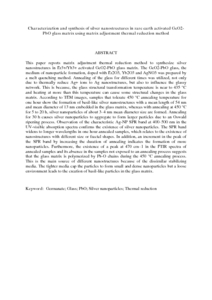Citation
Bahari , Hamid Reza and Zamiri, Reza and Abd. Aziz, Sidek and Zakaria, Azmi and Mahamd Adikan, Faisal Rafiq
(2013)
Characterization and synthesis of silver nanostructures in rare earth activated GeO2-PbO glass matrix using matrix adjustment thermal reduction method.
Entropy, 15 (5).
pp. 1528-1539.
ISSN 1099-4300; ESSN: 1099-4300
Abstract
This paper reports matrix adjustment thermal reduction method to synthesize silver nanostructures in Er3+/Yb3+ activated GeO2-PbO glass matrix. The GeO2-PbO glass, the medium of nanoparticle formation, doped with Er2O3, Yb2O3 and AgNO3 was prepared by a melt quenching method. Annealing of the glass for different times was utilized, not only due to thermally reduce Ag+ ions to Ag nanostructures, but also to influence the glassy network. This is because, the glass structural transformation temperature is near to 435 °C and heating at more than this temperature can cause some structural changes in the glass matrix. According to TEM images, samples that tolerate 450 °C annealing temperature for one hour show the formation of basil-like silver nanostructures with a mean length of 54 nm and mean diameter of 13 nm embedded in the glass matrix, whereas with annealing at 450 °C for 5 to 20 h, silver nanoparticles of about 3–4 nm mean diameter size are formed. Annealing for 30 h causes silver nanoparticles to aggregate to form larger particles due to an Oswald ripening process. Observation of the characteristic Ag-NP SPR band at 400–500 nm in the UV-visible absorption spectra confirms the existence of silver nanoparticles. The SPR band widens to longer wavelengths in one hour annealed samples, which relates to the existence of nanostructures with different size or fractal shapes. In addition, an increment in the peak of the SPR band by increasing the duration of annealing indicates the formation of more nanoparticles. Furthermore, the existence of a peak at 470 cm–1 in the FTIR spectra of annealed samples and its absence in the samples not exposed to an annealing process suggests that the glass matrix is polymerized by Pb-O chains during the 450 °C annealing process. This is the main source of different nanostructures because of the dissimilar stabilizing media. The tighter media cap the particles to form small and dense nanoparticles but a loose environment leads to the creation of basil-like particles in the glass matrix.
Download File
![[img]](http://psasir.upm.edu.my/30029/1.hassmallThumbnailVersion/Characterization%20and%20synthesis%20of%20silver%20nanostructures%20in%20rare%20earth%20activated%20GeO2.pdf)  Preview |
|
PDF (Abstract)
Characterization and synthesis of silver nanostructures in rare earth activated GeO2.pdf
Download (188kB)
| Preview
|
|
Additional Metadata
Actions (login required)
 |
View Item |

